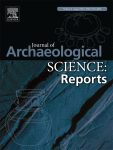Journal

Journal of Archaeological Science: Reports
Volume 8, August 2016, Pages 366–380
Physical and chemical properties of the ancient glass beads from the highland log-coffin culture and the lowland areas, Thailand: Considerations on their colors and technology
Seriwat Saminpanyaa, , Natamon Bavornyospiwata, Sunisa Homklina, Sumalee Danyutthapolchaia, Pimtida Bupparenoob
Abstract
The ancient glass beads from a log coffin cave at Pang Mapha, Mae Hong Son as well as from Sa Kaeo, Thailand, were studied for their physical and chemical properties. The samples have an average specific gravity of 2.25, and an average refractive index of 1.55. The glasses show typical inclusions of swirls and gas bubbles, suggesting drawn production. Copper and iron are the main sources of the blue and green glasses, confirmed by the UV–Vis–NIR spectra, whereas the lead stannate is responsible for the yellow and iron for the black beads. Lead, as a color intensifier, is dominant in a gradual change from yellow to green, to blue samples, respectively. The main raw materials could possibly be silica sand, reh, and stannate. There are some evidences indicating recycled raw materials. We found that people on the northern highland of the log coffin culture had a connection to the low land community in the central and eastern regions of the country during the years of ~ 260–560 CE. The technology of glass making for the studied glasses is the same as those used in the Dvaravati Kingdom glasses found in the sites of central Thailand.
Keywords
Ancient; Glass bead; Log coffin; Colorant; Technology; Thailand
